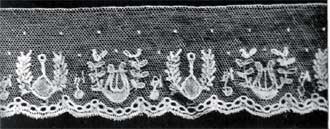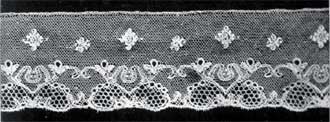Lille & Arras Lace
Lille Lace
There is not much interest attached to the bobbin-lace of Lille, for it is commonplace and undistinguished. Yet at one time, the late eighteenth century, it was wonderfully popular in England, and such quantities of it were imported that specimens are easily acquired by the collector. The ground of Lille lace is the hexagonal mesh of which an enlargement is shown inthe nextplate, a reseau known as fond clair, or fond simple, four sides of which are formed of two twisted threads ; the threads of the remaining two sides being only crossed, not twisted.

The edge of Lille lace is invariably almost straight, never markedly waved or scalloped, and the formal patterns are out?lined with the thick, flat, shiny thread which English lace-workers call gimp or trolly thread. The reseau is often powdered with little square dots known as points d'esprit. Lille lace survived the Revolution, but by the year 1800 its most distinctive features had disappeared, and the patterns of the lace then being made were more or less in the style of the later Mechlin laces.
Arras Lace
Arras was , from the earliest ages, renowned for its tapestries and needlework. the nuns of the convent excelled in all kinds of needlework," and lace-making was in 1602 the principal occupation of the institution of the Filles de Sainte-Agnes.It became famous for its bobbin lace that was almost identical with lace made in Lille. Owing to its early repute as a centre of bobbin lace, Arras was chosen as an establishment of the points de France, and Valenciennes were copied there with some success in 1713.

In the later eighteenth century, Arras, like Lille, made a quantity of narrow light lace, which went by the name of " mignonette," which was very popular during the Empire (1804-12), since which period it has declined. In 1800, the laces of Lille and Arras were the only "dentelles communes" in vogue, and their strength, whiteness, and low price assured them a market . The lace was durable, firm and perfectly white. For a period Arras specialized in the making of gold laces. Britain bought immense supplies of Arras lace.
